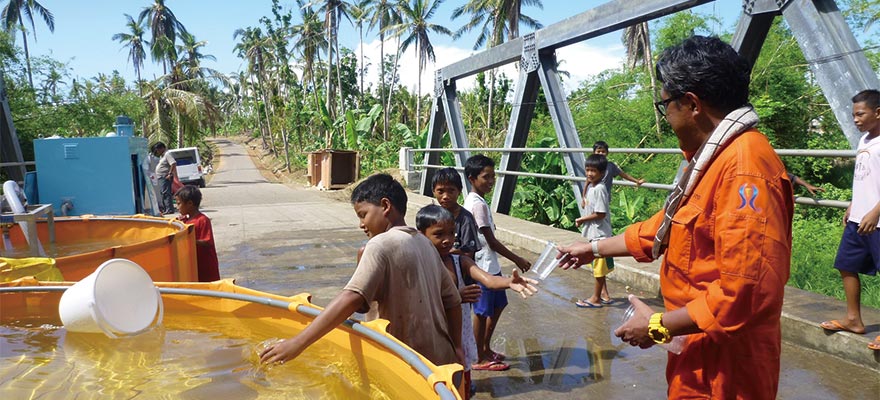Home > Highlighting JAPAN >Highlighting Japan February 2014>Living with water
Highlighting JAPAN
Living with water
Waste-Free Water Treatment
Nihon Genryo Co., Ltd.

Many people around the world rely on water purification plants to provide them with safe, reliable drinking water. Filter sand, derived from natural sand, is used in the process of purifying water to remove turbidity, or cloudiness, such as suspended sludge in raw water.
More than 80 percent of the filter sand used in purification plants in Japan today is provided by Nihon Genryo Co., Ltd., helmed by Yasuhiro Saito. The company was founded in 1939, when it refined sand for use in glass production. After the Second World War, Nihon Genryo's expertise in sand led it to be hand-picked to handle the reconstruction of Japan's heavily-damaged water purification system. It has been at the center of the nation's water filtration development ever since.
"The diameter of one particle of filter sand is just 0.6 millimeters," Saito explains. "But if impurities adhere to the surface of these particles, they get bigger, and their filtration capability deteriorates. It used to be that filter sand was changed and disposed of every seven or eight years. But the total amount of filter sand available for purification is limited, and this practice would lead to the exhaustion of the resource. That's why filter sand began to be washed and recycled. But from the 1970s, declining raw water quality due to pollution made it impossible to purify water to a suitable level using filter sand cleaned through conventional washing methods."
Through a process of trial and error, Nihon Genryo developed a filter sand cleaning machine, dubbed the Siphon Washing Filter Sand System, which creates twin vertical and horizontal vortices that cause sand particles to knead each other in a three-dimensional washing action. This revolutionary new cleaning technique, which relies only on physical action, neither requires the use of chemicals nor produces waste like other conventional methods of cleaning filter sand.
Developed on the principle of singing sand, which squeaks when walked on, the Siphon Washing System can exfoliate sludge without any damage to the size of the sand grain. In addition, because the system causes neither crashing nor wearing of the particles, filtration capability is projected to be maintained without deterioration almost indefinitely. This technology has received the Commendation for Science and Technology by the Minister of Education, Culture, Sports, Science and Technology (MEXT), as well as the National Commendation for Invention and numerous other awards, with patents registered in 33 countries.
In 2002, Nihon Genryo incorporated the Siphon Washing System into its Siphon Tank purification device, which can produce filtered water of consistent quality without replacing the filter sand. This device's high water-volume discharge capabilities have drawn the attention of companies and organizations seeking to treat industrial wastewater, and has made a major contribution to the realization of non-polluting zero-emission efforts. Furthermore, in a typical purification device, adhered sludge is floated up and removed from the filter sand by spouting pure water up from the bottom of the device in a regular process of backwashing. Use of the Siphon Washing System eliminates the need for both the water and energy required for this backwashing process.
Developed in 2005 as a filter sand purification device, the Mobile Siphon Tank is a downsized and lightened version of the Siphon Tank. When Tomiyoshi Water Treatment Plant in Miyazaki Prefecture was struck by a strong typhoon that same year, Mobile Siphon Tanks were deployed to provide clean drinking water to the affected areas.
The company's aid efforts extend beyond the shores of Japan: "We worked with JICA to offer relief in the Philippines in the wake of the recent typhoon," Saito says. In the aftermath of the massive typhoon that struck in November 2013, Mobile Siphon Tanks provided fresh water to as many as 20,000 people in five villages.
In addition to the company's humanitarian efforts for areas affected by disasters, orders for Siphon series products are growing throughout Asia. Meanwhile in Europe, when Nihon Genryo first exhibited at an international trade fair in Germany in 2005, Ectron Electronic Gmbh was so impressed with the company's technology that the two companies united in a joint project that saw Siphon Washing Systems installed and utilized at public swimming pools in Germany.
Looking to the future, with increasingly ecological approaches demanded in the water purification field, Saito says, "I believe that the future holds great possibility for the eco-friendly Siphon Washing System."
© 2009 Cabinet Office, Government of Japan






